Artists vs. AI
Value, Risks, and Threats
Welcome to Polymathic Being, a place to explore counterintuitive insights across multiple domains. These essays explore common topics from different perspectives and disciplines to uncover unique insights and solutions.
Today’s Topic digs deep into the current rift between artists and AI. We’ll investigate the value of art and then dive into the history of technological advancements to help contextualize the angst about AI within the Art community. This essay has been one of my most difficult to write as there are so many nuances to tease out properly.
Intro
A contentious topic has emerged that I’ve dealt with face-to-face over the past year; Artists vs. AI. It’s incredibly important to me as an artist and author and it’s also important to me as a technologist because we miss a lot of valuable insights and enablers if we make this a false binary and pit AI against Artists without context.
I’ve poked a bit at this discussion over the past two years such as exploring Can AI be Creative? and on how we teach and train art creation for both AI and artists in AI Is[‘nt] Killing Artists. Therefore, this essay will focus on the threat artists feel when AI is used to create art and the angst that it causes. To start, let’s step back and look at “Art” in general and then dig deeper to uncover the roots of the conflict.
What is Art?
The dictionary definition of Art is pretty aligned with what we’d expect.
Art: The expression or application of human creative skill and imagination, typically in a visual form such as painting or sculpture, producing works to be appreciated primarily for their beauty or emotional power.
Creativity and imagination enter the equation and good expression, skill, and application produce artistic outcomes that connect and unlock emotions. It can be as practical as an elegant code module, aesthetic like a well-structured room, or transcendental like the Notre Dame Cathedral.
That said, art is also subjective and influenced by the social milieu. The hard truth is that a lot of what we call art is art because we named it so. For example, I posted this meme on Substack Notes regarding how I feel a lot of the conversations about AI-generated art sounds regarding much human-created art.
For context, that big red painting is named “Vir Heroicus Sublimis” or "Man, Heroic, Sublime." It is an expression of creativity and imagination but also very basic. I contend this art carries most of its meaning because its name has meaning. In many ways, like much of modern art, I find it pretentious alongside a plethora of cringe examples that demonstrate just how subjective human-created art can be.1
Another Value of Art
To really understand the full value of art we have to recognize that there’s another layer beyond just the observers’ appreciation. Jacqueline Rendell articulates:
Art is an expression of our divinity, our spirit, our unique selves. Using AI as a tool to aid/support creativity or for gaining 'insight' is not equivalent to using it as a replacement for inner exploration, healing, or authentic expression.
She hits a valuable point that art captures the “inner exploration, healing, or authentic expression.” Neal Stephenson takes a similar approach and describes the artistic process as microdecisions that go into a human creation where:
The categorical error made over and over again by idea havers is to mistake the actual production of the artwork—the making and fixing of the microdecisions—for mere drudgery that can, and ought to be, done away with.
I like the way he phrased that and it highlights that the value of the artistic creation is both the quality of the output for the observer as well as the value of the learning and expression of the creator. It’s both transcending the ordinary as well as allowing the artist to grow. I think this last bit is a crucial piece we can’t lose.
My writing is a great example as I take an idea, form, uniform, and reform it logically and critique it to uncover counterintuitive insights. The value to both you and me is that we can learn, unlearn, and relearn together. I like to say, “Good writing should surprise the author.” While this captures the value of human artistic creation, we now need to put this in context with AI and its impact on this process.
Artificial Creativity
Judson Stacy Vereen, in an essay challenging the meme above, denigrates AI for being ‘Artificial’ and I admit, it’s an unfortunate term that we discussed in Augmenting Intelligence. It immediately Triggers a belief that AI is counter to human intelligence and therefore, fake sparking visceral reactions against using AI for any reason.
Ethan Mollick’s book Co-Intelligence captures this exact quandary. Contrary to the Artificial creativity Judson sees, Ethan describes it as Automated Creativity. In Chapter 5 he clarifies:
“This tends to make us uncomfortable: Afterall, how can AI, a machine, generate something new and creative? The issue is that we often mistake novelty for originality.
This idea is exactly what we found in Can AI Be Creative? Ethan goes further by explaining how LLMs are connection machines that weave together concepts and come up with novel, but not necessarily original, concepts. This is a critical point to understand in where humans add value to art and a key thing to remember is that AI still requires a human to guide it.
AI is a machine that requires human creativity and imagination to articulate the goal and intelligence to guide AI through the process. It follows that the output remains “the expression or application of human creative skill and imagination.” In context it’s not any more artificial than using a camera instead of painting, using a musical synthesizer instead of an instrument, or using a computer instead of hand-scribing a novel. AI as a technology, requires human input and this brings up a risk in its use.
The Risk of AI
A major concern I have about AI, and one that underlies this entire conversation, is the risk of dehumanizing content. The siren call of faster content creation often results in marginal, derivative, and formulaic content. This is where we hit a major schism in the conversation.
There are content creators blatantly ignoring human exploration and expression with no consideration or appreciation for the value of human creation.
Artists react to this by creating a binary that all AI generation cannot include human exploration and expression.
I think this is a major kernel of the conflict between Artists and AI, and rightly so, but it doesn’t quite capture the fear that is also mixed into the conversation. On one hand, AI opens up a key opportunity to differentiate pure human art but on the other hand, an artist who recognizes the middle ground and protects the human connection can create valuable content more quickly. This insight helps us understand the fear of AI.
The Fear of AI
Let’s step back quickly and understand a crucial piece of the puzzle. Artists aren’t unique in their imagination and creativity compared to anyone else. Instead, what differentiates artists is they invested time and training in pure artistic mediums whereas others invested their time in other disciplines and crafts.
It’s like the apocryphal story of Picasso sketching on a napkin and then asking $10K for the art to which a woman responds, “But you did that in thirty seconds.” “No,” Picasso said. “It has taken me forty years to do that.” He spent forty years exploring styles and developing skills.
The fear is that this investment of time can be replaced with a simple prompt in an image generator. I can relate. Having written two novels and over 100 essays here, I’ve invested time mastering my writing in both composition and speed and it took years to reach proficiency. Now GenAI puts out decent content in seconds.
This identifies the real threat; AI is reducing this time investment.2 Moreover, it democratizes the availability of artistic tools to more people who don’t need to invest that time.3 David Knickerbocker describes it well:
This is no trivial threat to artists, many of whom have dedicated their lives to the mastery of a medium. It’s an existential threat to many graphic artists and creates a greater expectation of competency for many other artists. AI raised the bar for artists to compete while simultaneously lowering it for non-artists to create art. It sounds terrible but we have to understand that this isn’t the first time this threat has emerged.
The Fear Throughout History
History is replete with nearly identical arguments over everything from Plato railing against the written word, to scribes opposing the printing press, to painters protesting photographers, and photographers lamenting cellphone cameras. The pattern goes back to nearly every artistic discipline and reflects the same fear: technology saves time and opens the door of art to more people and this threatens artists who invested a lot of time in learning their craft.
A case in point; my own mastery of writing benefits from computers, keyboards, and word processors. Every published author today uses different levels of AI for their cover art, their written content, and their printing, distribution, and marketing, none of which existed just 40 years ago. This is best evidenced by the ability to publish to Amazon and other platforms without involving a single human.
Just one hundred years ago I would be limited to hand-writing on reams of paper and painstakingly recomposing, formatting, and editing by hand. Today I bypass that time investment with my computer, word processors, grammar checks, and more. Technology enables me to write and publish novels and these essays as a hobby without having to dedicate my life to the art. Does that make my writing less artistic than those 100 years ago or does technology enable artistic creation for more people?
I do appreciate the feelings of these artists whose livelihoods are challenged. I also appreciate the thousands of crafts that have gone away with the steady progression of technology over history. Consider that virtually no job exists today in the same capacity as one hundred years ago due to changes in technology. AI is one more step in reducing the time investment while also unlocking new creative possibilities.
Unlocking Creativity.
What is often overlooked in this debate is that technology in general and AI specifically also unlock the creativity and imagination of thousands of people when it is used to Augment Intelligence. I’ll make this personal as I use AI-generated art in many of my essay’s title images. I do this because they look better than the human-created stock art I was paying for and it takes mere minutes to generate prototypes and refine them.
I can now create compelling, unique, and visually attractive art for each of my essays by plugging in my creative writing ideas, with my strong imagination, and guiding the technology with critical direction. In short, I use technology to express my creativity and imagination instead of hoping someone else can understand my vision or being reduced to using substandard stock images.4
Another way I’ve used AI to unlock creativity is when my kids started writing their own stories while I was writing The Singularity Chronicles. My daughter wrote about gemstone dolphin cats and my son wrote about Chicken and Turtle on an adventure. When they finished a chapter, I’d reward them with the use of an AI image generator so they could see their ideas unfold and learn the technology. Excited by seeing their imagination come to life, they’d dive back in and keep writing while hand-drawing their own concepts to refine their ideas for better prompting in the future.
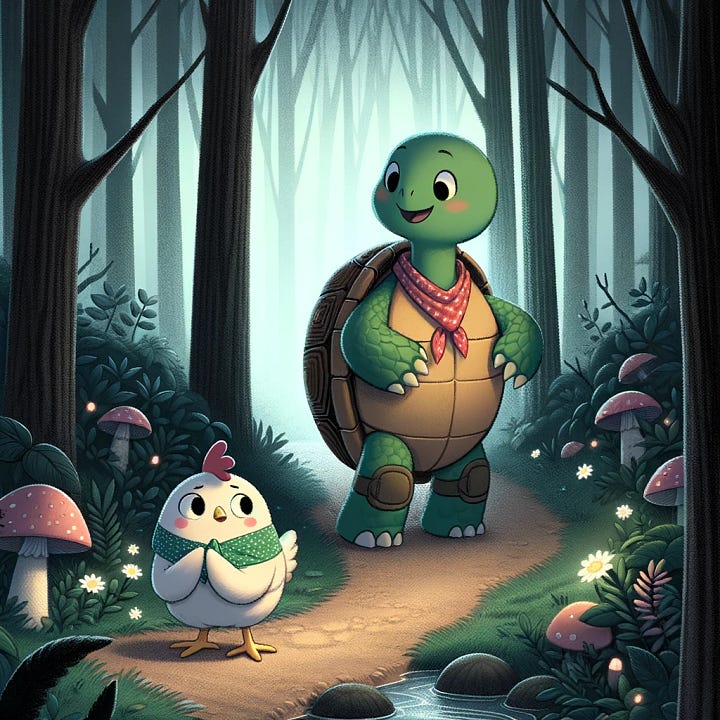
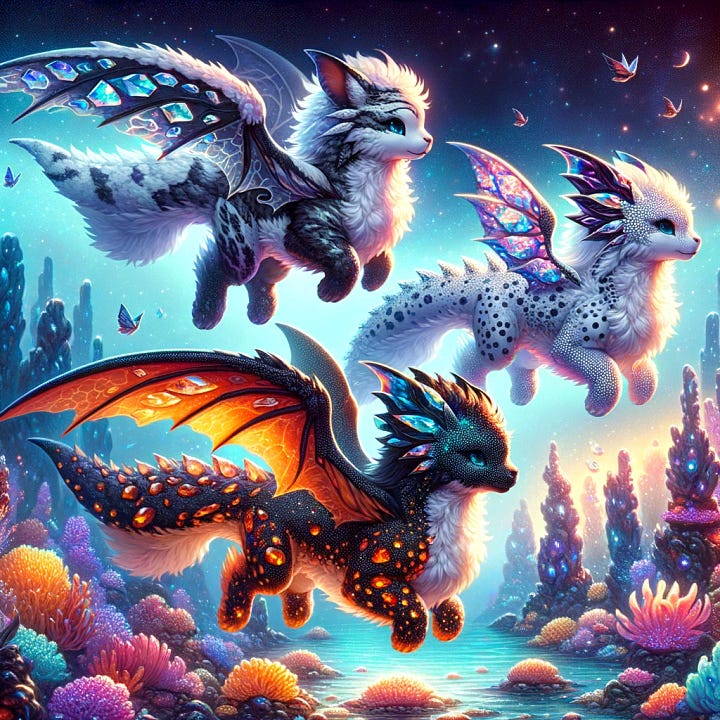
Two examples from writing are an author I know whose husband has a fantastically creative mind but crippling dyslexia. He can’t write and struggles to work with writers to capture his ideas. Enter ChatGPT which has inordinate patience and can take the ideas and bring them to life so he can edit. The second example is an author I met who has a progressive neurological disorder threatening her ability to write. She uses AI to help capture her ideas while her body fails. It’s her imagination and creativity expressed through technology before it’s too late.
Both examples highlight AI as a tool that helps unlock art whether through time, skills, or assistance. AI isn’t replacing the exploration and microdecisions but enabling focus on different decisions and explorations. Even better, used right it can force us to challenge our own biases to improve our decisions and explorations.
Conclusion
Over time we’ve also invented technologies that make artistic creation easier. Whether writing, printing, painting, photography, weaving, and more, we see that the arguments aren’t Artists vs. AI, it’s the risk of removing the human and the threat of reducing the amount of time required to produce art. Knowing these risks we can also see that technology hasn’t destroyed art. It most often unlocked the ability for more people to express their creativity and imagination.
To conclude I’d like to quote fellow Sci-Fi author Isaac Asimov from his introduction in The Naked Sun on the topic of robotics and AI:
To me, it always seemed that the solution had to be wisdom. You did not refuse to look at danger, rather you learned how to handle it safely.
After all, this has been the human challenge since a certain group of primates became human in the first place. Any technological advance can be dangerous. Fire was dangerous from the start, and so (even more so) was speech — and both are still dangerous to this day — but human beings would not be human without them.
New technologies, like AI, allow artists to adapt, innovate, and uncover new styles that can retain a human focus while expanding art long into the future. With centuries of technology behind us, we don’t have less art in the world, we have more art and more artists everywhere. Going forward we can continue that trend by understanding the true value of art and using that to be more human.5 It doesn’t have to be Artists vs. AI; it can be an enabler to unlock even more art.
This was a hard essay to write and it forced me to evolve and refine my own position. I formed, unformed, and reformed this essay dozens of times and it still needs continuous conversations because it is so nuanced, emotional, and prone to binary thinking. If you want to go deeper we've covered a lot of topics here:
Explore whether AI can be creative and uncovers how creative we are:
What are the risks to artists and what we can do about it:
Here’s how Art is the foundation of STEM:
Lastly, come find out how AI can Augment your Intelligence:
Enjoyed this post? Hit the ❤️ button above or below because it helps more people discover Substacks like this one and that’s a great thing. Also please share here or in your network to help us grow.
Polymathic Being is a reader-supported publication. Becoming a paid member keeps these essays open for everyone. Hurry and grab 20% off an annual subscription. That’s $24 a year or $2 a month. It’s just 50¢ an essay and makes a big difference.
Further Reading from Authors I Appreciate
I highly recommend the following Substacks for their great content and complementary explorations of topics that Polymathic Being shares.
Goatfury Writes All-around great daily essays
Never Stop Learning Insightful Life Tips and Tricks
Cyborgs Writing Highly useful insights into using AI for writing
Educating AI Integrating AI into education
Mostly Harmless Ideas Computer Science for Everyone
Judson Stacy Vereen took umbrage with this meme and wrote an essay challenging the description. He proffered a value of human-created art as bringing us back to a childlike state of wonder. I understand that view but find it lacking because, 1. That’s easy and 2. It’s a crutch I’ve found most defenders of modern art require to add value.
The same is true for Whisky where the longer aged garner higher prices whereas technology can create a whisky that tastes old much faster. Check out An Ode to Whisky.
Another example are the elite extremes of creating your own pigments, paper, and brushes to be better attuned to the medium than using commercially available products. This requires even more time to produce art demonstrating the barrier to entry.
Ironically, the cover image for this essay was surprisingly difficult to produce using AI. It took over three times as long and I had to fight the entire way. However, as I progressed, I continually refined my queries and polished my concepts. This process forced me to come back and edit this essay twice more to better articulate my points as well.
Just a day after putting down my keyboard on this essay, James Hammer penned a guest essay for Nick Potkalitsky entitled The Human in the Loop: Learning to Work with Technology We Never Asked For and captured many of the same sentiments about unlocking human creativity that we explored here.



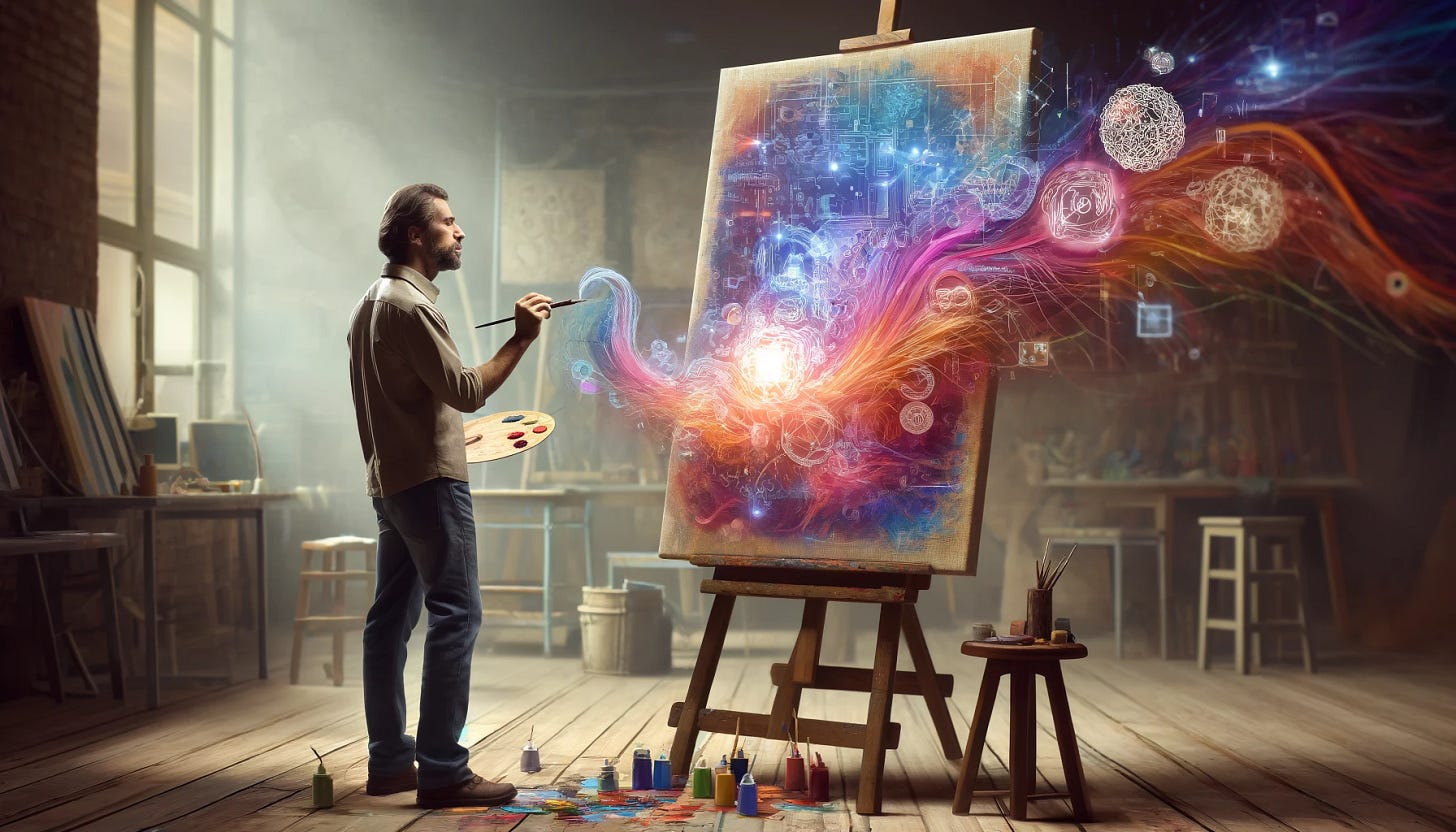
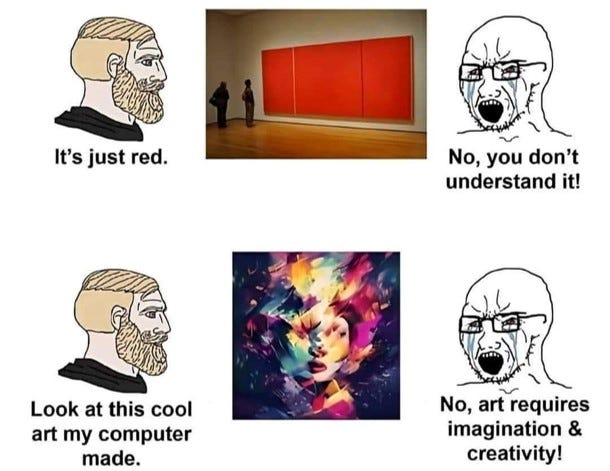

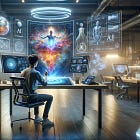




![AI Is[n't] Killing Artists](https://substackcdn.com/image/fetch/$s_!qytx!,w_140,h_140,c_fill,f_auto,q_auto:good,fl_progressive:steep,g_auto/https%3A%2F%2Fsubstack-post-media.s3.amazonaws.com%2Fpublic%2Fimages%2F48e90ab2-1185-4e39-afe9-4316457c7f59_2560x1440.jpeg)

It seems you are using "art" to cover everything from MoMA-level work to basic commercial illustration - that's a big range to make blanket statements about. There is a huge range in between, just like the craft of writing can range from Nobel prize literature to genre (sci-fi, romance) and to Buzzfeed-like listicles, or just like telling stories with video and music ranges from Apocalypse Now to your average Netflix series to 10-second TikTok entertainment. AI tools have completely taken over (and "enshittified" as Cory Doctorow says) one end of the range, are being deployed to massively improve productivity/volume in the middle, but are and will remain an option, at the discretion of the artist, at the high end.
Good post. Funnily enough I just posted my own take on the AI vs. Art question earlier today.
I work as both an artist and a graphic designer, and I feel the threat of AI in both fields. But what I've come to realise (and this is only partially articulated in my own essay) is that in regards to my artwork, I think engaging with the question is incredibly valuable, but I don't care about finding "the answer". For me, the finished work (usually collage) is less important than the time spent with it. To me it would have little/no value if it came from an LLM (or smaller, more specialised AI tool). The value is in the time spent, engaging with the piece, and making the decisions. And whether the finished product is good, whether it's "creative" or "original", or pretentious (your examples were maybe a little too cherry-picked :)), so be it. Working as an artist is making the work.
Anyway, thanks again and looking forward to more essays.